Abstract
Two temperature-sensitive (ts) strains, 1B and 1H, were obtained after nitrosoguanidine treatment of the wild-type virulent abortive ovine strain Chlamydia psittaci AB7. Optimum growth temperature on McCoy cells was 38 degrees C for the three strains, but at the restrictive temperature, 39.5 degrees C, ts strains differed from the parental strain in their total infective yield of chlamydiae, their efficiency of plating, and the morphology of the plaques and cytoplasmic inclusions. Their survival at 51 degrees C was also reduced compared with that of the wild field strains. The virulence of the two ts strains was attenuated for pregnant mice, but these two ts strains were able to multiply in mice and to induce a strong immunity to virulent challenge with either the parental AB7 strain or the caprine or bovine abortive field strains.
Full text
PDF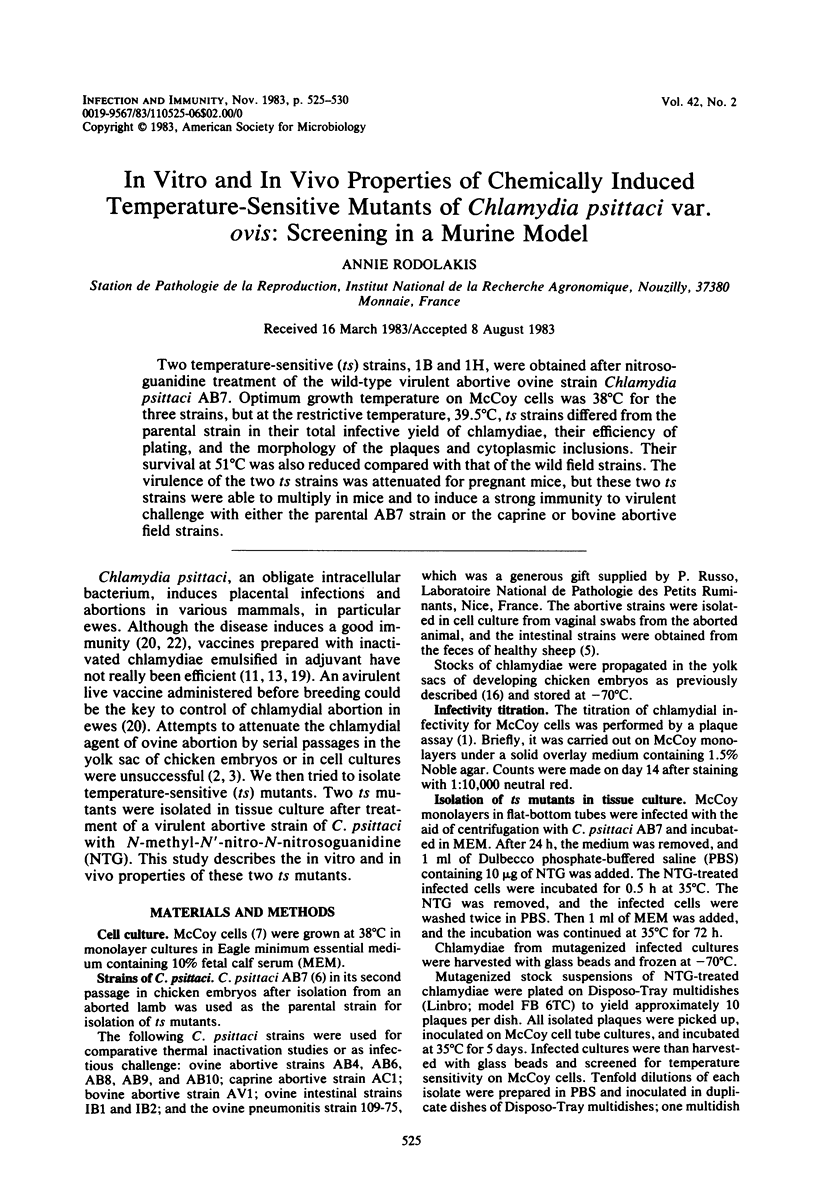
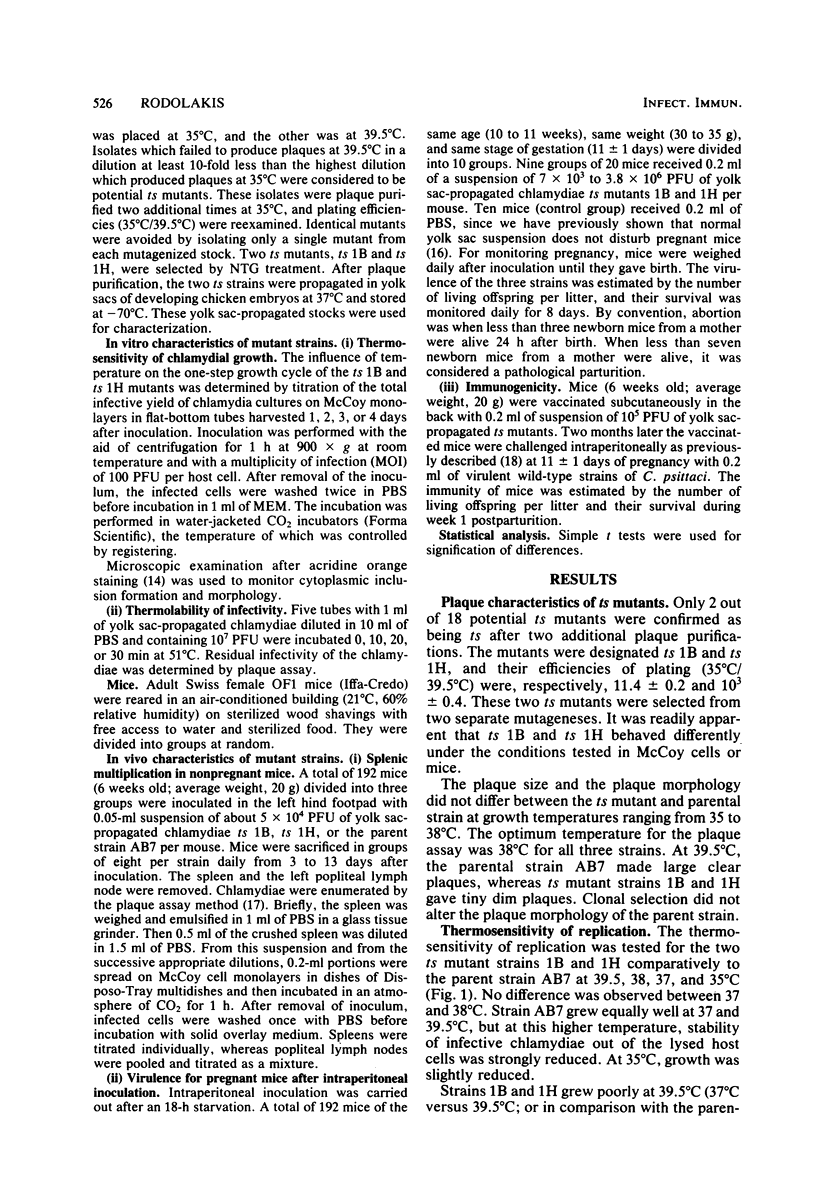
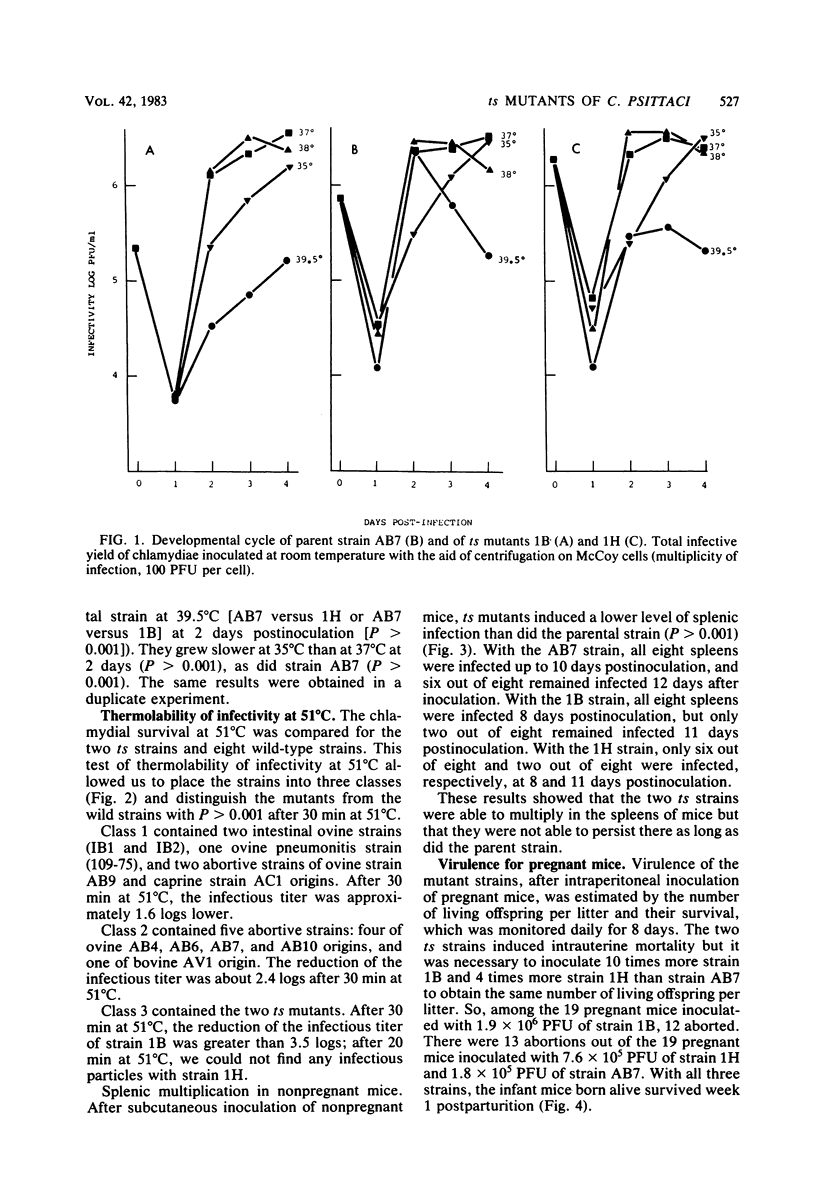
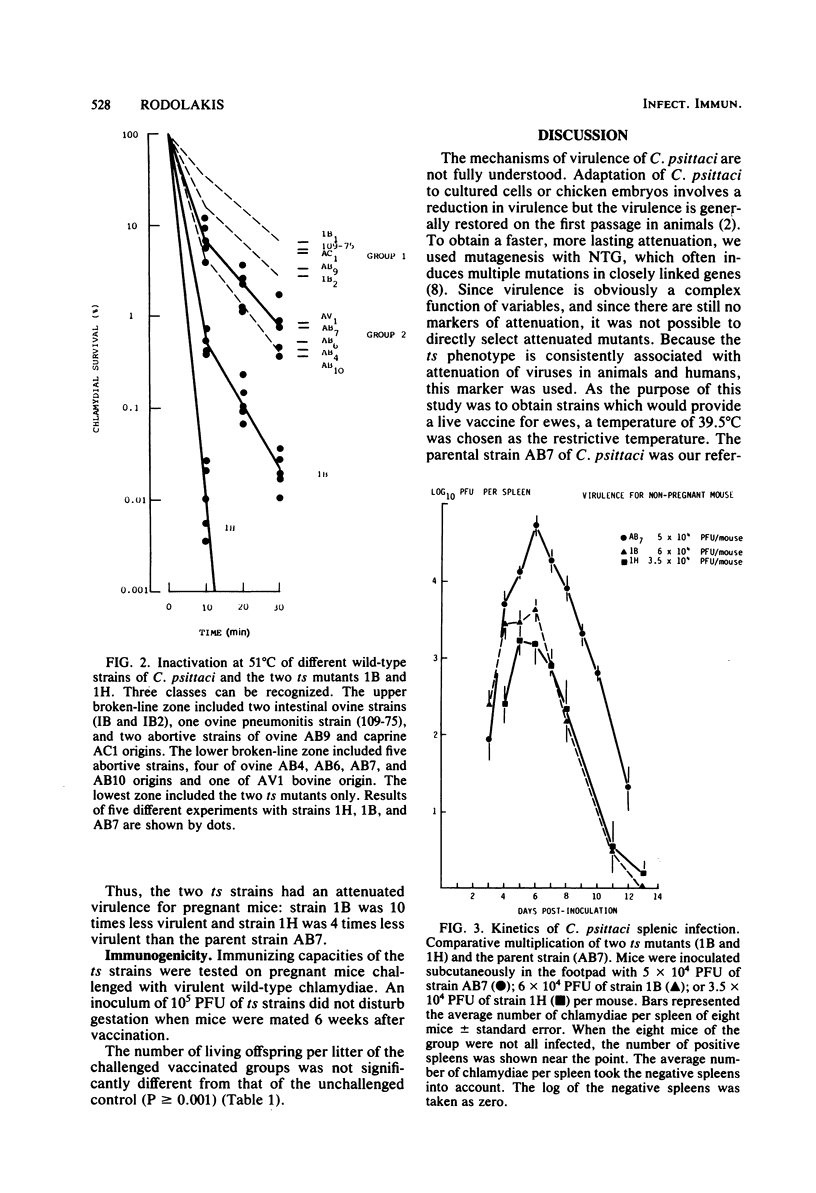
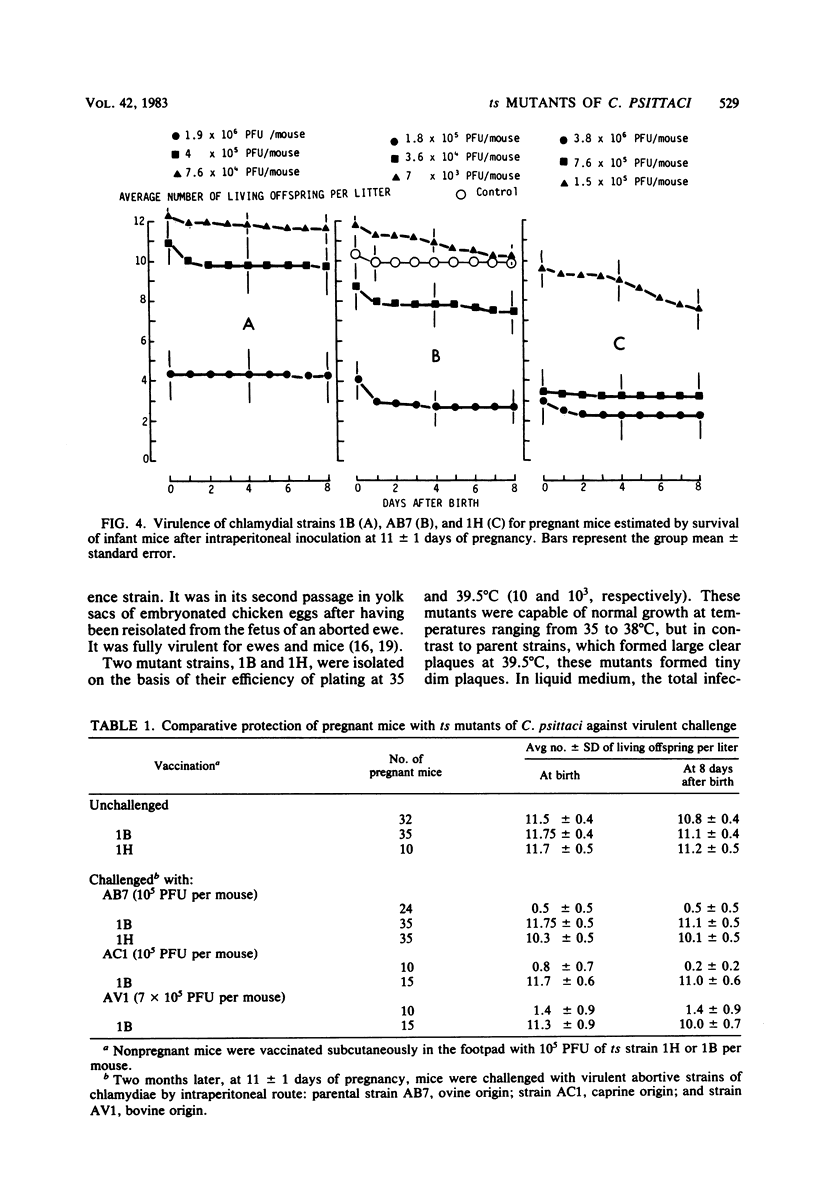
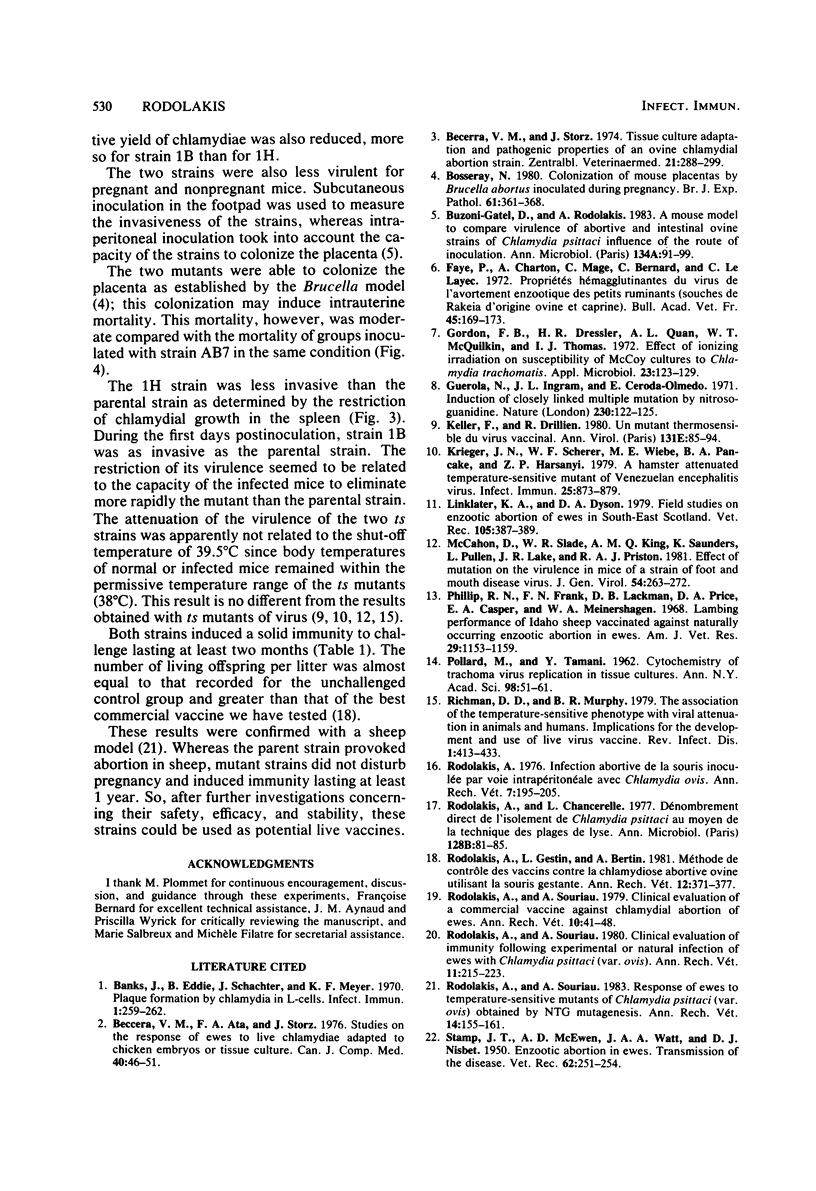
Selected References
These references are in PubMed. This may not be the complete list of references from this article.
- Banks J., Eddie B., Schachter J., Meyer K. F. Plaque formation by Chlamydia in L cells. Infect Immun. 1970 Mar;1(3):259–262. doi: 10.1128/iai.1.3.259-262.1970. [DOI] [PMC free article] [PubMed] [Google Scholar]
- Becerra V. M., Ata F. A., Storz J. Studies on the response of ewes to live chlamydiae adapted to chicken embryos or tissue culture. Can J Comp Med. 1976 Jan;40(1):46–52. [PMC free article] [PubMed] [Google Scholar]
- Bosseray N. Colonization of mouse placentas by Brucella abortus inoculated during pregnancy. Br J Exp Pathol. 1980 Aug;61(4):361–368. [PMC free article] [PubMed] [Google Scholar]
- Buzoni-Gatel D., Rodolakis A. A mouse model to compare virulence of abortive and intestinal ovine strains of Chlamydia psittaci: influence of the route of inoculation. Ann Microbiol (Paris) 1983 Jan-Feb;134A(1):91–99. doi: 10.1016/0769-2609(83)90107-2. [DOI] [PubMed] [Google Scholar]
- Gordon F. B., Dressler H. R., Quan A. L., McQuilkin W. T., Thomas J. I. Effect of ionizing irradiation on susceptibility of McCoy cell cultures to Chlamydia trachomatis. Appl Microbiol. 1972 Jan;23(1):123–129. doi: 10.1128/am.23.1.123-129.1972. [DOI] [PMC free article] [PubMed] [Google Scholar]
- Guerola N., Ingraham J. L., Cerdá-Olmedo E. Induction of closely linked multiple mutations by nitrosoguanidine. Nat New Biol. 1971 Mar 24;230(12):122–125. doi: 10.1038/newbio230122a0. [DOI] [PubMed] [Google Scholar]
- Krieger J. N., Scherer W. F., Wiebe M. E., Pancake B. A., Harsanyi Z. P. A hamster-attenuated, temperature-sensitive mutant of Venezuelan encephalitis virus. Infect Immun. 1979 Sep;25(3):873–879. doi: 10.1128/iai.25.3.873-879.1979. [DOI] [PMC free article] [PubMed] [Google Scholar]
- Linklater K. A., Dyson D. A. Field studies on enzootic abortion of ewes in south east Scotland. Vet Rec. 1979 Oct 27;105(17):387–389. doi: 10.1136/vr.105.17.387. [DOI] [PubMed] [Google Scholar]
- McCahon D., Slade W. R., King A. M., Saunders K., Pullen L., Lake J. R., Priston R. A. Effect of mutation on the virulence in mice of a strain of foot-and-mouth disease virus. J Gen Virol. 1981 Jun;54(Pt 2):263–272. doi: 10.1099/0022-1317-54-2-263. [DOI] [PubMed] [Google Scholar]
- POLLARD M., TANAMI Y. Cytochemistry of trachoma virus replication in tissue cultures. Ann N Y Acad Sci. 1962 Mar 5;98:50–61. doi: 10.1111/j.1749-6632.1962.tb30531.x. [DOI] [PubMed] [Google Scholar]
- Philip R. N., Frank F. W., Lackman D. B., Price D. A., Casper E. A., Meinershagen W. A. Lambing performance of Idaho sheep vaccinated against naturally occurring enzootic abortion in ewes. Am J Vet Res. 1968 Jun;29(6):1153–1159. [PubMed] [Google Scholar]
- Richman D. D., Murphy B. R. The association of the temperature-sensitive phenotype with viral attenuation in animals and humans: implications for the development and use of live virus vaccines. Rev Infect Dis. 1979 May-Jun;1(3):413–433. doi: 10.1093/clinids/1.3.413. [DOI] [PubMed] [Google Scholar]
- Rodolakis A., Chancerelle L. Dénombrement direct à l'isolement de Chlamydia psittaci au moyen de la technique des plages de lyse. Ann Microbiol (Paris) 1977 Jul;128B(1):81–85. [PubMed] [Google Scholar]
- Rodolakis A., Gestin L., Bertin A. Méthode de contrôle des vaccins contre la chlamydiose abortive ovine utilisant la souris gestante. Ann Rech Vet. 1982;12(4):371–377. [PubMed] [Google Scholar]
- Rodolakis A. Infection abortive de la souris inoculée par voie intrapéritonéale avec Chlamydia ovis. Ann Rech Vet. 1976;7(2):195–205. [PubMed] [Google Scholar]
- Rodolakis A., Souriau A. Clinical evaluation of a commercial vaccine against chlamydial abortion of ewes. Ann Rech Vet. 1979;10(1):41–48. [PubMed] [Google Scholar]
- Rodolakis A., Souriau A. Clinical evaluation of immunity following experimental or natural infection of ewes with Chlamydia psittaci (var. ovis). Ann Rech Vet. 1980;11(2):215–223. [PubMed] [Google Scholar]
- Rodolakis A., Souriau A. Response of ewes to temperature-sensitive mutants of Chlamydia psittaci (var ovis) obtained by NTG mutagenesis. Ann Rech Vet. 1983;14(2):155–161. [PubMed] [Google Scholar]
- STAMP J. T., McEWEN A. D., WATT J. A. A., NISBET D. I. Enzootic abortion in ewes; transmission of the disease. Vet Rec. 1950 Apr 29;62(17):251–254. doi: 10.1136/vr.62.17.251. [DOI] [PubMed] [Google Scholar]


